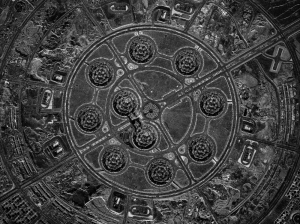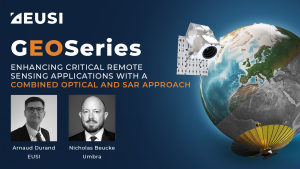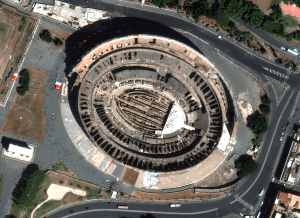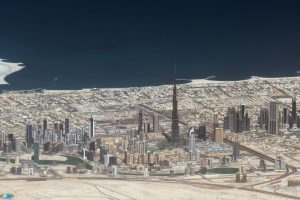Europe’s SAR and Optical Satellite Integration
- European Space Imaging
- 15 April, 2019
Europe’s all-inclusive integrated solution to leverage the power of SAR and VHR optical satellite imagery
European Space Imaging is the only European supplier that is now able to offer its customers an all-inclusive integrated solution that incorporates the power of SAR data combined with the detail of VHR satellite imagery at 30 cm spatial resolution. This innovative offer allows customers one point of contact for their project requirements to provide rapid delivery of vital imagery.
The integration of SAR with VHR optical satellite imagery is of high interest to many security, defence and surveillance authorities in addition to environmental agencies and municipalities to assist in making informed decisions.
Why use SAR data?
Synthetic Aperture Radar (SAR) data is a form of radar that actively transmits a series of short, radar pulses to the ground illuminating the target. By receiving the reflected signal two-dimensional images or three-dimensional information about objects on Earth can be determined.
SAR has high-resolution capabilities by synthesizing the aperture resulting from the forward movement of the instrument over an object on ground. SAR can penetrate darkness, clouds and rain making it very versatile as the time of day or weather conditions don’t need to be considered. It is particularly useful for a wide range of applications such as environmental monitoring of oil spills or urban growth in addition to military surveillance, including strategic policy and tactical assessment.
Why use VHR optical data?
Very High Resolution (VHR) optical data ranges from 30 – 80 cm in spatial resolution and offers the highest image quality currently available from commercial remote sensing satellites. Offering a smaller ground sampling distance (GSD) than other imaging satellites, this data is superior in classifying smaller objects such as specific models of vehicles, vessels and airplanes. This powerful tool is also a critical resource for monitoring landscapes, natural disasters, structural changes and other situations requiring high precision data. The versatility of the imagery makes it a valuable source of information for both commercial and military needs.
Combining SAR data and VHR optical data
While alone SAR and VHR data both have their benefits, combined they become a powerful source of information. SAR is able to cost effectively and easily image large areas in a short amount of time. However, it lacks both the spatial and spectral resolution that comes from VHR optical imagery. On the other hand, VHR optical imagery is dependent on limiting factors such as the time of day and weather conditions, something that SAR data doesn’t need to account for. Therefore, when a project covers an extensive area to search for small objects such as vessels at sea or monitoring borders, it is faster, less expensive and more reliable to use a combination of SAR data and VHR optical data.
How the process works
Once a large area of interest has been determined, collection process is initiated. Firstly, SAR data is collected, downlinked and processed. Immediate and automated analysis of the SAR image determines targets that are of interest to the user. Based on this information, direct optical satellite tasking of the area of interest is then initiated from the European Space Imaging’s Ground Station located in Munich, Germany. This process of combining data from multiple sensors is called tipping and cueing. Thanks to the local tasking capabilities, changes to the optical tasking requests can be made right up until the acquisition takes place. These changes may be due to weather conditions or mission updates. Delivery of the complete image package (fully analysed and annotated SAR and VHR imagery) occurs within hours of the initial request, which is critical to time-sensitive events such as those faced by defence and security intelligence bodies. This enables authorities to respond quickly and execute informed decisions from the data to ensure the most constructive outcome.
Related Stories

What is SAR Imagery? Introduction to Synthetic Aperture Radar
SAR imagery enables all-weather monitoring, penetrates dry soil, and offers resolution as high as 25 cm. Thanks to that, it’s invaluable for applications like emergency response, defence and intelligence, or agriculture. How does SAR work? What are its advantages and limitations? And what other data sources can you integrate it with? Read the article to learn more.

Enhancing Critical Applications With A Combined Optical and SAR Approach
For the first time in history, users can schedule synchronised collections of 25 cm SAR and 30 cm Near Real-Time optical imagery to mitigate weather and gain deeper insights of events unfolding on the ground. This is especially valuable for Emergency Response, GEOINT and other applications.

18 European Landmarks in Satellite Images
Satellite sensors captured unique architecture, breathtaking nature and centuries of history. Explore the Colloseum, La Sagrada Familia, the Leaning Tower of Pisa, and other landmarks.

Understanding ONA in Satellite Imagery: What is Off Nadir Angle and What Is It Used For?
Off Nadir Angle (ONA) plays a crucial role in the quality of optical satellite imagery. It influences its resolution and clarity, decides the visibility of features, and makes it easier or harder to identify objects. Moreover, ONA is used to create stereo imagery and 3D models of the Earth’s surface. Read on to learn more.





